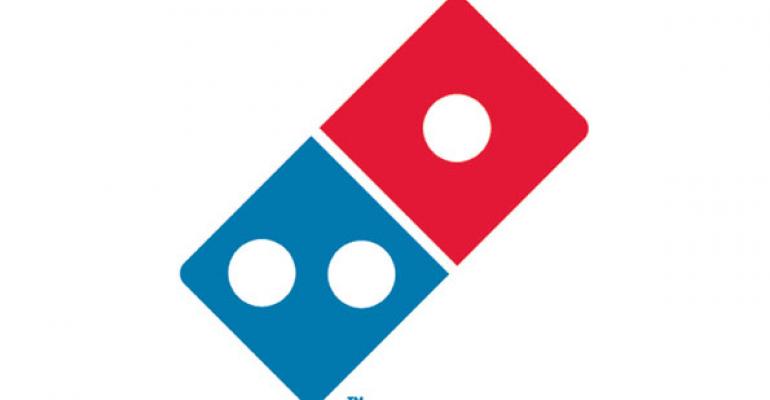Domino’s Pizza Inc. will accelerate its remodeling program to convert all of its nearly 11,000 restaurants worldwide to the “Pizza Theater” prototype by the end of 2017.
The company expects reimaging costs to range between $40,000 and $55,000 per store, to be borne entirely by the brand’s franchisees, officials disclosed during Domino’s annual Investor Day event Wednesday. New stores would cost about $250,000 to $350,000 to build
RELATED
• Domino’s Pizza to offer hands-free ordering from car
• Domino’s Pizza 3Q net income rises 17.7%
• More Domino's news
Leaders of the Ann Arbor, Mich.-based chain said the massive remodeling effort would be a catalyst for long-term same-store sales growth, which the brand has updated from an ongoing range of annual increases between 1 percent and 3 percent for its domestic restaurants to a new long-term target of 2 percent to 4 percent.
“If we get this right and get this done,” chief executive Patrick Doyle said, “this is one more thing as you look at the transformation of the Domino’s brand, both in the U.S. and around the world, that we think is going to continue to really drive the momentum on this brand.”

Domino’s announcement came the day after the segment leader Pizza Hut opened two stores that offer pizza by the slice, which experts said could shift major pizza players toward growing dine-in sales and traffic at lunch.
Like Pizza Hut’s leaders, Domino’s officials recognized that consumers’ changing needs for more convenience and more upscale environments could play to the strengths of the burgeoning fast-casual pizza segment but insisted that the remodeling program was not just a response to new competition.
“The most important definition of fast casual … to my mind is giving consumers what they want today, versus what you built your business around 25 years ago,” Doyle said.
Fast-casual chains, in pizza or any other segment, are offering better-quality food, modern environments with open kitchens, convenience and relative value, even at slightly higher price points, he said. “If you listen to that list I just gave,” he said, “there was one thing that wasn’t completed yet for Domino’s, which is that you’ve got to have a better-looking restaurant.”
Domino’s last major design overhaul was announced and implemented in the summer of 1997, Doyle said. Currently, only about 200 restaurants in the United States carry the Pizza Theater design.
An extension of turnaround campaign
Doyle began the company’s day of presentations by comparing where Domino’s was in 2008 to where it is in 2014 to highlight the brand’s transformation across several areas. The chain’s positioning has gone from “uninspired” to “unique,” he said, and the pizza has improved from “just OK” to the current offering that was completely relaunched at the end of 2010.
Doyle added that Domino’s has grown from a newcomer to online ordering in 2008 to a “digital leader” today. Also, while the brand’s international business was “strong” in 2008, today that system of more than 5,600 units is accelerating its growth.
“That’s a heck of a five-year run,” Doyle said. “It’s been pretty transformational. … But as much as we like the progress we’ve made, the bottom line is there is still a lot of share to be taken.”
The brand’s growth in digital ordering has led to market-share gains over the past several years, mostly at the expense of independent pizzerias and smaller chains, he added. But while that will continue to grow, the store redesigns would also serve to extend the turnaround campaign begun with a new pizza and new advertising in 2010 down to the store level.
“This is not just, ‘Hey, we’re going to put some paint on the store,’” chief marketing officer Russell Weiner said. “There’s a reason why Patrick asked the marketing team to lead the store redesign. His vision was that the store needs to be a reminder of who we are as a brand. When you watch TV and then come into the store, there’s not a disconnect.”
The major feature of the “Pizza Theater” store design is transparency, in keeping with Domino’s repositioning itself as a transparent brand, Weiner said. There will be more visibility from the outside of the restaurant into a brighter, more modern dining room, with a handful of seats for customers waiting on pick-up orders or deciding to have lunch on site. Once inside, customers will have better sight lines to the make line and pizza ovens through a more open kitchen.
The reimaging would also extend to new uniforms for crew members, a new logo and even a new car topper for delivery drivers, Weiner said.
Doyle and Weiner stressed to investors that expanding the Pizza Theater design systemwide would not inhibit the growth of Domino’s core delivery business.
“Evolving doesn’t mean you’re walking away [from delivery],” Weiner said. “Evolving can be an ampersand, adding to the carryout business as well.”
Securities analyst Stephen Anderson of Miller Tabak + Co. characterized the remodeling program as a likely engine for top-line growth over the next few years. He wrote in a research note that carryout now accounts for 30 percent of Domino’s domestic sales.
“We expect this to become an increasingly important catalyst for the company in the next couple of years, as we think the new prototype will compete aggressively against new fast-casual pizza concepts,” Anderson wrote. “We estimate the inclusion of seating areas could add $150,000 to $300,000 in annual average unit volume, representing an increase of 20 percent to 40 percent.”
Domino’s operates or franchises nearly 5,000 locations in the United States and more than 5,600 restaurants in 70 international markets.
Contact Mark Brandau at [email protected]
Follow him on Twitter: @Mark_from_NRN





